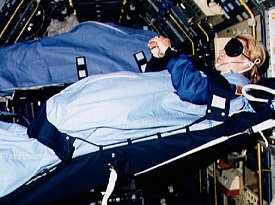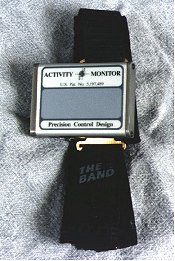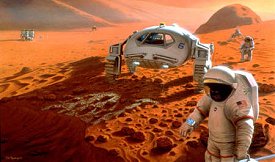|
Space travel can be exciting - and restless!
NASA researchers are exploring ways to help astronauts enjoy a better
night's sleep on the space station... and beyond.
By Karen Miller
Astronauts sleep poorly in space, and
it's no wonder. Just consider: the excitement of blasting off on
a powerful rocket, the strange sensations of floating in free-fall,
the novelty of mornings that return every 90 minutes... Who could
sleep through all that?
On some space shuttle missions up to
50% of the crew take sleeping pills, and, over all, nearly half
of all medication used in orbit is intended to help astronauts sleep.
Even so, space travellers average about 2 hours sleep less each
night in space than they do on the ground.
That deficit adds up, says Dr. Ken
Wright, Instructor in Medicine at Harvard Medical School, and Associate
Neuroscientist at Brigham and Women's Hospital. "Research performed
on Earth suggests that some of them, after a week or two on this
restricted sleep schedule, are performing at the level of someone
who's been awake for 24-plus hours.”
Fatigue, on Earth or in space, is
a serious problem. It affects performance, increasing irritability,
diminishing concentration, and decreasing reaction time. And it
increases the risk of accidents.
On Earth, sleep can be disrupted by
anything from a crying baby to tomorrow's exam. In space wakefulness
can come from noise and excitement - and, possibly, the disruption
of the circadian rhythms that ensure a good night's sleep.
Sleep is, in large part, managed by
our body's master clock, which is located in the brain's hypothalamus.
This clock regulates the body's daily production of melatonin, a
sleep-promoting hormone, and cortisol, a hormone that promotes wakefulness,
and is also associated with stress. The clock also manages a multitude
of other physiological cycles, including body temperature, growth
hormone production, heart rate, and urine production. The circadian
clock generates these cycles all on its own. But there's a problem.
Free-running, the master clock produces cycles that average about
24.2 hours - slightly longer than Earth's day. So the clock must
be reset. It needs to be adjusted daily to ensure that the biological
day and night don't get out of sync with the environment. On Earth,
it's reset automatically, simply by our exposure to the high intensity
light of day.

Motion restraints
and a dark mask help this floating astronaut fall asleep aboard
the brightly-lit freely falling space shuttle.
|
But in space, the right cue isn't so
easily provided. The space shuttle orbits Earth every 90 minutes.
So, instead of receiving the Terran pattern of 12 hours of light
followed by 12 hours of dark, astronauts on the shuttle's flight
deck experience 45 minutes of light succeeded by 45 minutes of dark.
This rapid-fire exposure might disrupt - or as sleep researchers
say, "disentrain" - the astronauts' circadian cycle.
It's important that the cycle be entrained:
that the astronaut's biological day matches the environmental one.
"The circadian system is set so that you're best prepared to be
alert and awake during the biological day, and to sleep at [biological
night],” says Wright. If the body is required to perform activities
at the wrong biological time, he explains, it will not function
optimally.
For that reason NASA sometimes deliberately
shifts the astronauts' cycles before sending them into space, making
sure that their biological day coincides with the crucial period
of launch, according to Dr. Bette Siegel, a scientist in the Bioastronautics
division at NASA headquarters. Effecting the shift is easy: astronauts
are exposed to high intensity light at key times for three to ten
days before liftoff. By the time the shuttle is ready to leave Earth,
the crew is bright-eyed and alert.
Once in orbit the biological clocks
of astronauts might need to be adjusted further to align with another
critical time - the moment of landing. It's done by requiring the
crew to wake up earlier and earlier each day.

Credit: Brigham and Women's Hospital, Harvard
Medical School, NASA Ames, and UC San Diego.
This device,
as worn by astronauts, documents sleep patterns in space.
|
Researchers still aren't sure exactly
what happens to the circadian clocks of astronauts under such circumstances.
To help find out, astronauts wear a wrist device that tracks astronaut
sleep patterns along with their light exposures. "We have models,”
says Wright, "where we can take their sleeping history and their
light exposure history and predict what's going to happen to their
[internal] clock.” The device, along with sleep diaries kept
by the astronauts, will help researchers figure out which factors
- such as light exposure, temperature, or ambient noise in the close
confines of a spacecraft - affect sleep most during spaceflight.
But even with this information, scientists
still need to answer some basic questions in order to develop countermeasures
against unwanted wakefulness. For instance, what exactly controls
the master clock? What intensity of light will trigger it - and
which colours? Does gravity itself provide a cue? All these questions
will grow in importance as humans move farther into space.
Take the exploration of Mars, for example.
On Mars, daylight is primarily yellowish-brown. On Earth, it's blue-green.
How will the human clock respond to the unearthly colour of Martian
skies? Some research indicates that it could make a difference.
Melatonin production, for example, is suppressed more by some wavelengths
of light than by others.

Artist Pat Rawlings painted this beautiful
scene. [more]
The unearthly
colour of Martian daylight could scramble the circadian rhythms
of human explorers.
|
Of more concern, perhaps, is the length
of the Martian day: 24 hours and thirty-nine minutes. "That is significantly
different than the period of the clock in humans,” notes Wright.
It's possible, he says, that the human clock might not be able to
adapt to Mars. Ongoing research addresses this question by exploring
countermeasures - for example, different patterns of light exposure
- that will entrain the human clock to a longer day.
Learning to manage the circadian clock
is critical to exploring space. But astronauts are hardly the only
ones with sleep problems.
"The space environment," says Wright,
"provides us with a unique opportunity to understand something more
about the functions of sleep." Part of the research involves trying
to understand ways to promote wakefulness for shift workers, or
people suffering jet lag, or simply for the many people who don't
get enough sleep.
"It's an exciting topic,” says
Wright, "because it affects everyone.” Indeed, countermeasures
that Wright and his colleagues devise for astronauts in space might
well provide a more restful night for those of us remaining on Earth.
|
